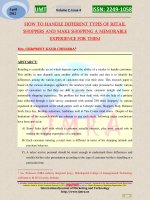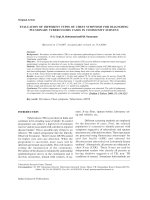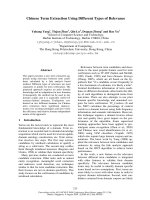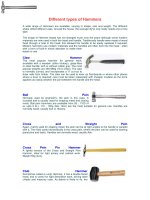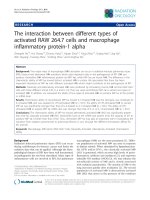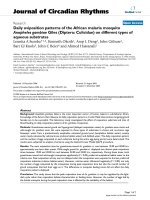Different types of sewing machines
Bạn đang xem bản rút gọn của tài liệu. Xem và tải ngay bản đầy đủ của tài liệu tại đây (1.24 MB, 27 trang )
Ashikur Rahman Ranok
Bgmea University of fashion &
Technology(BUFT)
What is Sewing Machine?
•
A sewing machine is a machine used to stitch fabric
and other materials together with thread.
•
A sewing machine is a machine which does all the
stitches automatically, so it's easier and quicker than
hand stitching.
•
A sewing machine is a textile machine used to stitch
fabric, cards and other material together with thread.
1. Basic sewing machines in garments industry are used for
numerous applications.
2. Generally available in three versions :
i. Sewing with light materials.
ii. Sewing with medium materials.
iii.Sewing with heavy materials.
3. Speed up to 6000 s.p.m with electronic controls for
acceleration.
4. Electronically controlled thread cutting, needle positioning,
back tacking mechanism through the foot pedal, foot lifting
system available in this machines.
5. Programmable sewing sequence via a micro processes for
repetitive operation.
6. A great variety of feed systems, attachments and apparatus
available to make the machine more versatile.
Features of Basic Sewing Machines
According to the operating system, there are two types of
sewing machines:
1. Manually operated sewing machines :
Driven by physical energy.
Used for domestic and tailoring purposes.
Less production, but more laborious.
Low cost.
1. Electrically operated or Industrial sewing machines :
Usually driven by electric power.
High productivity.
Used in garments industry.
Cost is high.
Types of Sewing Machines
Electrically operated/Industrial Sewing Machines
At present there are used two types of electrically operated
sewing machines in garments industry :
o
Semi-automatic electrical sewing machines.
o
Computerized sewing machines.
Most common manufacturer of electrical/industrial sewing
machines (semi-automatic) are given below:
Brand Name Made in
JUKI Japan
BROTHER Japan
SINGER England
BUTTERFLY China
SiRUBA Taiwan
There are various types of electrically operated or Industrial
sewing machines. Among them, features of some most usable
machines are described below :
o
No. of needle : generally 1 needle or 2 needles.
o
SPM : 1500 – 5500.
o
Stitch Length : 5 mm in Juki DDL 5500 Model.
o
Automatic thread cutting and bobbin winding.
o
Edge cutting system.
o
More secured sewing.
o
Most commonly used for sewing of woven
garments.
1. Lock Stitch or Plain Stitch Sewing Machine
Fig 1 : Lock Stitch Machine
o Two types : Single Chain Stitch and Double Chain
Stitch.
o No. of needle: One or more
o No. of thread : One or more
o SPM : 1800 – 6000
o Stitch Length : 1.4 mm to 4.5 mm
o Automatic thread trimmer.
o Various types of feed mechanism is adjusted to the
machine.
o Used for both woven and knitted fabrics, specially to
sew jeans or denim wears.
2. Chain Stitch Sewing Machine
Fig 2 : Chain Stitch Machine
• No. of needle: 1 or 2.
• No. of threads : 2 - 5.
•
SPM : 6500 – 8500.
•
Stitch Length : 4mm (maximum) and it can be
adjusted by push button.
• Stretching : Maximum 1: 0.6 and Gathering :
Maximum 1:4
• Used for sewing both woven and knitted goods, but
extensively used for knitted goods.
3. Over Lock/Over Edge Sewing Machine
Fig 3 : Over Lock/Over Edge Sewing Machine
Special modification of lock stitch machine.
No. of needle: 1
No. of threads : 2
SPM : 5500
Stitch Length: 2 to 2.5 mm
Stitch Width: 5 to 10 mm
Used in edge stitching or decorative top stitching or
to fit extra component to garments, such as elastic,
tape, pipe etc.
4. Zigzag Lock Stitch Sewing Machine
Fig-4 : Zigzag Lock Stitch Sewing Machine
No. of needle: up to 4
No. of threads : 4 to 9
SPM : 6000
Stitch Density: 8 to 16 per inch
Thread consumption of this machine is
very high. So very expensive machine.
Used for knitted garments. But it can be
also used for woven garments.
5. Flat Lock Sewing Machine
Fig-5 : Flat Lock Sewing Machine
No. of needle: 1
No. of threads : 1 or 2
SPM : 2500
Stitch Length : 3 to 8 mm
Stitches are not seen on the face side of the fabric.
Curved needle is used.
Security is high for 2 thread blind stitch machine.
Very expensive.
Widely used for hemming and facing attaching.
6. Blind Stitch Sewing Machine
Fig-6 : Blind Stitch Sewing Machine
Stitch Group : Lock or Chain may be used.
For heavy fabric, hole is cut before sewing.
For lighter fabric, hole is cut after sewing.
Arrangement of stitch density being
increased or reduced.
To raise the stitch is called ‘Gimp’.
7. Button Holing Machine
Fig-7 : Button Holing Machine
Produces lock stitch, chain stitch or hand
stitch.
Button positioning can be automatic.
Sewing is according to the hole in button
and may be cross or parallel.
In fully automatic machines, button
feeding and positioning inside the button
clamp is performed by a hopper and pipe.
8. Button Attaching Machine
Fig-8 : Button Attaching Machine
Cyclic machine of strong sewing in very short length.
After making tack stitch in short length (1-2cm), cover
stitch (zigzag) is made on tack stitch and the no. of cover
stitch.
Used for sewing of belt loops, closing the ends of button
holes, for increasing strength at the ends of the pocket.
9. Bar Tack Machine
Fig-9 : Bar Tack Machine
Used for very fast and accurate sewing.
Very expensive and require very efficient operator, so rarely used in our
country.
Some examples of mostly used computerized sewing machines are given
below :
• Computer Controlled Cycle Machine with large Sewing Area.
• Cylinder Bed Machine with Automatic threads Trimming.
• 1-Needle, lock stitch unison feed machine with double capacity.
• 1-Needle, lock stitch portable Sewing machine with Automatic thread
Trimmer.
• 2-Needle, 2/3/4 thread over lock sewing machine with built-in rolled
hemming and differential feed.
• Automatic Jeans pocket setter with new automatic bobbin
winder/changer.
• 3-Needle, plain feed double loop seam machine with Tractor type presser
foot.
• High speed, lockstitch, buttonhole machine.
Computerized Sewing Machine
Fig-10 : Computerized Sewing Machine
